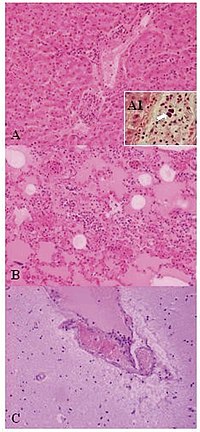
Photo from wikipedia
Candidate phylum radiation (CPR) bacteria comprise a poorly understood phylum that is estimated to encompass ∼26% of all diversity of domain bacteria. Among CPR bacteria, the Saccharibacteria lineage (TM7) is… Click to show full abstract
Candidate phylum radiation (CPR) bacteria comprise a poorly understood phylum that is estimated to encompass ∼26% of all diversity of domain bacteria. Among CPR bacteria, the Saccharibacteria lineage (TM7) is of particular interest, as it is found in high abundance in the mammal microbiome and has been associated with oral disease. ABSTRACT Saccharibacteria (TM7), which are obligate episymbionts growing on the surface of host bacteria, may play an important role in oral disease, such as periodontitis (1, 2). As TM7 is a newly cultured lineage of bacteria, its research is limited by the small number of isolated representatives relative to the number of TM7 genomes assembled from culture-independent studies (3–5). A comprehensive view of both TM7 taxa and TM7 strain-level variations remains opaque. In this study, we expanded our previously developed TM7 baiting method into using many host bacteria in parallel, which allowed us to obtain 37 TM7 strains from the human oral cavity. These strains were further classified into low-enrichment (LE, n = 24) and high-enrichment (HE, n = 13) groups based on their proficiency at propagating on host bacteria. Of the 13 HE strains, 10 belong to “Candidatus Nanosynbacter sp.” strain HMT-352 (human microbial taxon) (6), enabling us to explore both the phenotypic and genomic strain variations within a single TM7 species. We show that TM7 HMT-352 strains exhibit a diverse host range and varied growth dynamics during the establishment of their episymbiotic relationship with host bacteria. Furthermore, despite HMT-352 strains sharing a majority of their genes, we identified several gene clusters that may play a pivotal role in host affinity. More importantly, our comparative analyses also provide TM7 gene candidates associated with strain-level phenotypic variation that may be important for episymbiotic interactions with host bacteria. IMPORTANCE Candidate phylum radiation (CPR) bacteria comprise a poorly understood phylum that is estimated to encompass ∼26% of all diversity of domain bacteria. Among CPR bacteria, the Saccharibacteria lineage (TM7) is of particular interest, as it is found in high abundance in the mammal microbiome and has been associated with oral disease. While many CPR genomes, TM7 included, have been acquired through culture-independent methods, only a small number of representatives have been isolated. Such isolated representatives, however, shed light on the physiology, pathogenesis, and episymbiotic interactions of TM7. Combined with genomic analyses, experiments involving isolated representatives can distinguish phylogenetic to phenotypic discrepancies and better identify genes of importance. In this study, we utilized multiple host bacteria in parallel to isolate TM7 bacteria and examined strain-level variation in TM7 to reveal key genes that may drive TM7-host interactions. Our findings accentuate that broad phylogenetic characterization of CPR is the next step in understanding these bacteria.
Journal Title: mSystems
Year Published: 2022
Link to full text (if available)
Share on Social Media: Sign Up to like & get
recommendations!